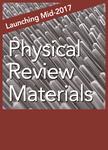版权所有:内蒙古大学图书馆 技术提供:维普资讯• 智图
内蒙古自治区呼和浩特市赛罕区大学西街235号 邮编: 010021

作者机构:Beijng National Laboratory for Condensed Matter Physics Institute of Physics Chinese Academy of Sciences Beijing 100190 China School of Physical Sciences University of Chinese Academy of Sciences Beijing 100190 China Materials Science and Technology Division Oak Ridge National Laboratory Oak Ridge Tennessee 37831 USA Materials Science and Engineering Program Department of Mechanical Engineering University of Texas Austin Texas 78712 USA Collaborative Innovation Center of Quantum Matter Beijing 100190 China
出 版 物:《Physical Review Materials》 (Physic. Rev. Mat.)
年 卷 期:2017年第1卷第2期
页 面:024406-024406页
核心收录:
基 金:DOD-ARMY, (W911NF-16-1-0559) U.S. Department of Energy, USDOE Office of Science, SC Basic Energy Sciences, BES Division of Materials Sciences and Engineering, DMSE National Natural Science Foundation of China, NSFC, (11574378) National Natural Science Foundation of China, NSFC Chinese Academy of Sciences, CAS, (XDB07030300) Chinese Academy of Sciences, CAS Ministry of Science and Technology of the People's Republic of China, MOST, (2014CB921500) Ministry of Science and Technology of the People's Republic of China, MOST National Key Research and Development Program of China, NKRDPC
主 题:Antiferromagnetism Chemical bonding Electrical conductivity Ferromagnetism Magnetic interactions Metals Pressure effects Perovskites Transition metal alloys
摘 要:Cubic SrCoO3 with an intermediate spin state can only be stabilized by high pressure and high temperature (HPHT) treatment. It is metallic and ferromagnetic with the highest Curie temperature of the transition-metal perovskites. The chemical substitution by Ca on Sr sites would normally lower crystal symmetry from cubic to orthorhombic as seen in the perovskite family of CaMO3 (M=M4+ of transition metals, Ge4+, Sn4+, and Zr4+) at room temperature. This structural change narrows the bandwidth, so as to further enhance the Curie temperature as the crossover to the localized electronic state is approached. We report a successful synthesis of the perovskite CaCoO3 with a HPHT treatment. Surprisingly, CaCoO3 crystallizes in a simple cubic structure that remains stable down to 20 K, the lowest temperature in the structural study. The new perovskite has been thoroughly characterized by a suite of measurements including transport, magnetization, specific heat, thermal conductivity, and thermoelectric power. Metallic CaCoO3 undergoes two successive magnetic transitions at 86 K and 54 K as temperature decreases. The magnetization at 5 K is compatible with the intermediate spin state t4e1 of Co4+ at the octahedral site. The thermal expansion of the Co-O bond length indicates that the population of high spin state t3e2 increases for T100K. The shortest Co-O bond length in cubic CaCoO3 is responsible for delocalizing electrons in the π*-band and itinerant-electron ferromagnetism at T54K. A comprehensive comparison between SrCoO3 and CaCoO3 and the justification of their physical properties by first-principles calculation have also been made in this report. Partially filled π* and σ* bands would make CaCoO3 suitable to study the Hund s coupling effect in a metal.